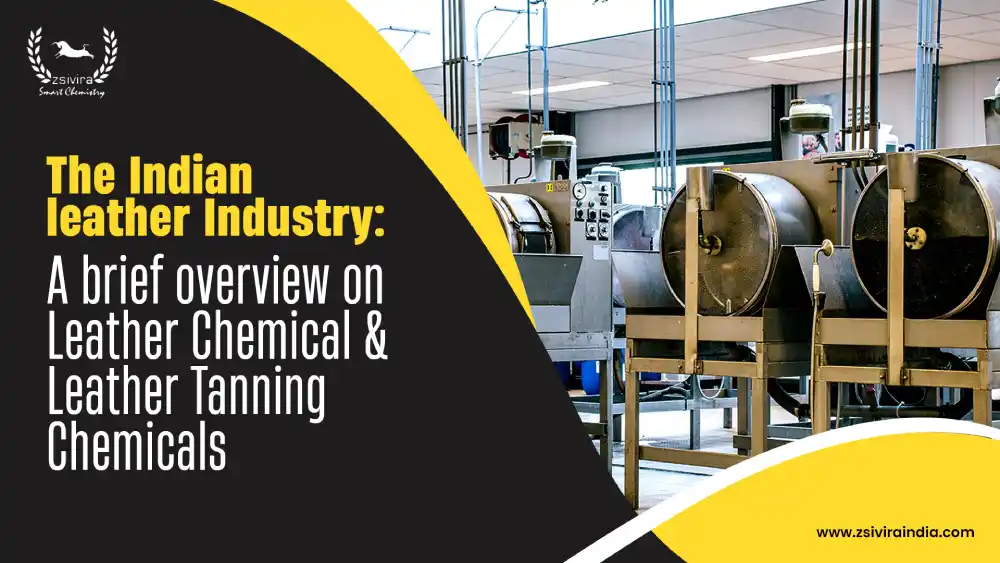DIN EN ISO 9001 CERTIFIED

In fashion and craftsmanship, leather is an eternal symbol of luxury, versatility, and timelessness. From ancient civilizations to modern runways, its allure has transcended time and culture, anchoring itself in the essence of human expression. However, behind this captivating material lies a complex process that involves the interplay of science, tradition, and innovation. At the heart of this intricate transformation lies the profound impact of leather chemicals and leather tanning chemicals.

The Indian leather industry, renowned for its intricate craftsmanship and unparalleled heritage, has evolved, embracing modern practices while safeguarding its legacy. The evolution of leather chemicals and tanning agents has been a defining chapter in this journey, redefining how leather is produced, processed, and perceived. In this exploration, we delve into the fascinating world of these chemicals and their role in the Indian leather industry, shedding light on their transformative journey and the promise of a greener, more sustainable future. This journey ensures the industry's longevity and aligns with the ethos of preserving natural resources for generations to come.
In its raw form, leather is a canvas of potential waiting to be unlocked. This unlocking of potential begins with leather chemicals, an array of substances that orchestrate the metamorphosis of raw animals hide into the luxurious material we adore. These chemicals are not mere additives but the architects of leather's texture, strength, colour, and durability.
The leather journey begins with preservation, where chemicals halt the march of time. Preservation chemicals thwart bacterial growth, ensuring the raw material remains intact. As Leather undergoes various stages, from soaking to tanning, different classes of chemicals join the orchestra. Surfactants and enzymes facilitate the removal of hair and impurities, ensuring a clean canvas for the artistry to follow.
Tanning, the pivotal stage that renders leather durable and supple, relies on leather tanning chemicals. These agents, classified into mineral and organic tanning agents, determine the final characteristics of the Leather. The introduction of chromium-based tanning chemicals brought efficiency and versatility to this process but also triggered concerns about environmental impact.
Leather tanning chemicals, led by the chromium revolution, have witnessed profound transformation. The introduction of synthetic tanning agents marked a pivotal shift in the industry, offering efficiency and variety previously unattainable. However, this advancement came with its own set of challenges, particularly concerning sustainability and environmental consequences.
Chromium tanning chemicals, notably chromium salts, revolutionized the tanning process. They facilitated faster tanning, reduced processing time, and enabled the creation of an expansive range of colours and textures. Yet, the environmental implications of chromium tanning, particularly the potential release of harmful substances, led to heightened awareness about the need for sustainable alternatives.
The global outcry for sustainable practices has resonated deeply within the leather industry recently. As the custodians of an ancient tradition, leather manufacturers are embracing innovative approaches to harmonize craftsmanship with ecological responsibility.
The concept of green chemistry, advocating for environmentally benign practices, has found a home in leather production. Natural tanning agents from quebracho, mimosa, and chestnut plants redefine Leather's journey. These alternatives reduce dependence on synthetic chemicals, resulting in distinct textures and colours.
Amidst this drive for sustainability, the renaissance of vegetable tanning emerges as a testament to the industry's commitment to tradition. Vegetable tanning, rooted in ancient practices, celebrates natural processes that yield biodegradable, toxic-free leather. This method aligns with the call for sustainability and yields products that age gracefully, a nod to the timelessness of Leather.
The fusion of biotechnology and leather chemistry introduces exciting prospects. Enzymes, revered for their natural catalytic abilities, are gaining prominence in leather processing. Enzymatic processes are efficient, energy-conserving, and generate fewer byproducts. Researchers are diligently optimising these processes for industrial implementation, promising a cleaner and swifter transformation. Moreover, bio-based tanning agents derived from agricultural byproducts symbolize the industry's commitment to sustainability. These agents marry innovation with ecological consciousness, forging a bridge between the past and the future.
As the Indian leather industry evolves, sustainability becomes a comprehensive philosophy. The pursuit of sustainability extends to responsible sourcing of raw materials, waste management, and ethical considerations. Closed-loop systems repurposing waste are gaining traction, reducing landfill contributions and signalling the industry's commitment to minimizing its footprint.

The journey of leather chemicals and tanning agents is a testament to the dynamism of the Indian leather industry. As global sustainability concerns gain prominence, the industry responds not with reluctance, but with resilience and innovation. It transforms challenges into opportunities, forging a future without sacrificing beauty for the environment.
In embracing the principles of green chemistry, rekindling the art of vegetable tanning, and embracing the marvels of biotechnology, the Indian leather industry is spearheading a greener path. The evolution of leather chemicals and tanning agents is a technical narrative and a legacy. In this legacy, generations will marvel at the craftsmanship and sustainability interwoven in every piece of leather.
In the grand tapestry of human industry, the Indian leather sector is stitching a chapter that balances tradition, progress, luxury, and responsibility. As these chemicals evolve, so does the story of an industry that has stood the test of time and is now determined to shape a future where elegance and ethics coexist seamlessly.
Leather has been a symbol of durability, luxury, and style for centuries. It's a versatile material used in various industries, from fashion to automotive, and its production...
Read moreIn fashion and craftsmanship, leather is an eternal symbol of luxury, versatility...
Read moreZsivira is a leading Fat liquor manufacturer, and our fat liquor is known for its high quality and durability. We use a proprietary blend of animal fats, oils, and waxes to create a fat...
Read more